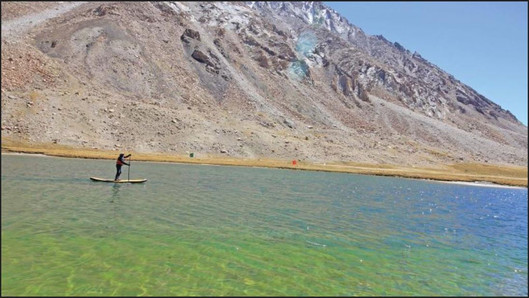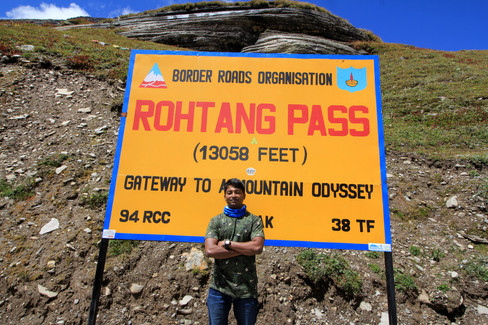Breaking Boundaries: The Journey to the World’s Highest Stand Up Paddle Boarding Attempt: Part 2
- Kumaran Geopaddler

- Sep 6, 2016
- 8 min read
Updated: May 25
2015 was an incredibly busy year; NASA’s Curiosity rover found yet another evidence of water on Mars, I was dedicated to collecting data, researching water bodies, and promoting paddle boarding in India. The sport was still new in the country, and I wanted to introduce as many people as possible to its joys and challenges. Many received the idea positively, which was a great boost to me at that time. Fast forwarding to July 2016, a group of young corporate professionals approached me with the idea of paddling in Leh-Ladakh. It was an intriguing prospect, paddle boarding at high altitudes, surrounded by the surreal beauty of the Himalayas. We made detailed plans, although I was still unsure if I would be joining them. Come September, everything was sorted, and I found myself embarking on another thrilling SUP India adventure.
The Road to Leh: Choosing the Path Less Traveled
Reaching Leh is no ordinary journey. The region, nestled deep in the Himalayas, has only two major roadways leading to it - Srinagar to Leh via Kargil, which is a historic yet politically sensitive route, and Manali to Leh Highway which is known for its extreme altitude, harsh terrain, and unpredictable weather conditions. Due to last-minute political instability in Srinagar, we opted for the Manali-Leh Highway. This road is considered one of the most dangerous in the world, with treacherous mountain passes, steep ascents, and unpredictable landslides. Well, the best views come with the greatest obstacles, as they say, it also offers some of the most awe-inspiring scenic views on Earth.
Crossing Rohtang Pass: The First Test
Our journey began with crossing Rohtang Pass (13,050 ft), infamous for its landslides and unpredictable weather. The name "Rohtang" literally translates to "pile of corpses" in Ladakhi due to the number of travelers who have lost their lives here. The climb was steep, the roads narrow, and the air started getting thinner. I knew the risks: less oxygen, severe headaches, and fatigue. But my excitement for paddle boarding kept me moving forward. The idea of bringing SUP India to such remote, untouched landscapes was worth the struggle. As we ascended, I began to experience the first signs of Acute Mountain Sickness (AMS) — a throbbing headache and dizziness. It occurs when the body struggles to adapt to lower oxygen levels at high altitudes. It starts off mildly with symptoms of headache, nausea, dizziness, and fatigue, but rapidly progresses to Shortness of breath, confusion, and loss of coordination. In extreme cases, one experiences high-altitude cerebral or pulmonary edema (HACE or HAPE). While it would feel discouraging to experience health issues while in the thrill of the expedition, one’s health needs to be the top priority at all times. To combat AMS, many trekkers take Diamox (Acetazolamide) to help the body acclimatize faster by increasing oxygen production in the blood. However, since I was not used to taking it, I decided to rely on hydration, slow breathing, and brief acclimatization stops.
Alongside the challenges, reaching the summit of Rohtang Pass was a moment of triumph for us. On one side, we saw lush green valleys, while on the other, barren, ice-covered peaks stretched into the horizon. It was like a dream – as if we had been transported right between the pages of a children’s fairy-tale. The descent began, we descended to our first campsite near the Beas River. The night sky was like an ethereal festival of lights, we were fortunate to witness the beauty of the visible universe. Countless shooting stars passed by. I wished upon one of them for my sickness to go away. I had planned to sleep under the stars, but my AMS symptoms worsened. My headache intensified, making it nearly impossible to sleep. But well, this was just the beginning. I caught a few winks, hoping my headache would clear as the sun came up.
Sarchu & Kang La Pass: Entering the Barren Wilderness
The next day, we had to cover nearly 300 km to reach Leh, crossing two other high-altitude passes. I wasn't as better as I would have liked, but much better than the night before. Within an hour of leaving our campsite, we had left the lush landscapes behind, and were now surrounded by barren, rocky terrain. We reached Sarchu, a crucial stop on the Manali-Leh route. Sarchu sits at an altitude of 14,070 ft and is considered the border between Himachal Pradesh and Ladakh. The landscape was surreal, endless plateaus surrounded by jagged mountain peaks. Well, with great heights come its own challenges – breathing became difficult and the temperature had dropped significantly. From Sarchu, we continued our climb towards Kang La Pass (17,100 ft). This pass is lesser-known but equally treacherous, with winding roads, sudden drop-offs, and chilling winds that test even the most seasoned travelers.
The lack of oxygen made even walking a challenge. Every movement felt like a test of endurance. After hours of travel that seemed never-ending, we finally crossed Chang La Pass, the second-highest motorable road in the world at 17,688 ft.
The Unexpected Paddle Boarding Opportunity
As we descended from Chang La Pass, I saw something incredible — a pristine glacial lake, about half a kilometer long. At first, it looked like nothing more than a pond. But as we drew closer, we realized it was a glacial lake. The water was crystal clear, reflecting the dry, towering mountains around it. The peaks had little snow, but the lake itself was fed by glacial melt, which meant the water was freezing cold.
Something inside me clicked. I hadn't originally planned to paddle here, but the sight of the lake was too tempting to ignore. I had brought my Naish stand up paddle board along, thinking I might find a chance to use it. And now, the chance had found me. Without thinking twice, I took out my stand up paddle board, started pumping air into it, and prepared to paddle on one of the highest lakes in the world. I had no idea at that moment that I was making yet another record. I was simply doing what I loved, paddling in untouched waters, experiencing the world from a unique perspective. And my, what an experience it was!
I started pumping my inflatable stand up paddle board, but I underestimated how difficult it would be. At 16,608 feet, even simple physical tasks feel exhausting. My muscles ached, my head pounded, and I could feel my heart racing as my body begged for oxygen.
The Naish board itself was light and reliable, perfect for high-altitude conditions, but inflating it felt like a workout in itself. Stand up paddle boarding may look effortless, but it demands strength and stamina.
The local tribal people nearby had a raft, and they watched curiously as I struggled to prepare my gear. My team, unfamiliar with SUP, couldn’t understand why I was pushing myself so hard. But I knew I had to do this, because if not now, then when? Finally, after what felt like eternity, my board was ready. I covered myself from head to toe to protect against the cold, fully aware that falling into the lake could cause hypothermia. At these temperatures, even a few minutes in the water could be fatal.
Despite my exhaustion, I stepped onto the board and started paddling. But once I was on the paddleboard, I was like a fish in the water. The lake was eerily quiet. The water was so clear I could see all the way to the bottom, and the silence was overwhelming - no boats, no people, just me and my board gliding over the lake. I paddled for nearly 50 minutes, absorbing every second of this surreal experience.
My team, watching from the shore, had no clue what I was doing, but their curiosity got the better of them and they trusted me enough to join me on the board for short stretches. At one point, some military personnel patrolling the area came over to see what I was doing. They were intrigued, and impressed. Stand up paddle boarding at this altitude was unheard of, and they congratulated me for my bravery. When I finally returned to shore, I was exhausted. My body ached, my lungs burned, and I collapsed onto the rocky ground, trying to catch my breath. I had no idea I had just set a world record. It took me two days to fully process what had happened.
Lake Tsoltak. A small, serene, freshwater lake spanning half a square kilometer, and a depth of less than 30 meters. Great to have put a name to the face, it had barely any record, thus was blissfully hidden. The previous highest recorded SUP session had been at 16,000 feet at Suraj Tal. That evening, I had surpassed the record by paddling at 16,608 feet, and I hadn’t even realised it. The altitude had been the biggest challenge - every paddle stroke felt like a battle, and my body had been pushed to its limits. But the reward was worth it. I had unknowingly made history, not for the sake of records but out of sheer love for stand up paddle boarding.
Crossing Khardung La and Nubra Valley
After resting in Leh, we decided to push further. We crossed Khardung La (18,380 ft), the world’s highest motorable pass, and descended into Nubra Valley. Here we caught glimpses of the route leading to the Siachen Glacier, the world’s highest battlefield. The journey felt surreal. I was still processing my unplanned record, but my heart was full of gratitude. I had seen places very few people had seen, paddled in waters even fewer had touched, and experienced the Himalayas in a way I never thought possible.
Looking back, this journey reinforced a crucial lesson: The best adventures are often unplanned.
Every major stand up paddle boarding achievement I had made, except for Godavari, was never about records or numbers. I went with the flow, followed my instincts, and let the journey unfold naturally. Throughout this journey, I had quite a few experiences. Travelling through some of the most dangerous roads in the world, I had witnessed the dramatic shift in Himalayan landscapes, something I knew only in theory. Although not a very fond memory, I had experienced the effects of AMS first-hand. Overall, this experience showed me what it is to explore and connect with nature with stand-up paddling in a way I have never known before.
This journey was another reminder that while paddle boarding in India is still in its early stages, it has immense potential. SUP India needs more pioneers, more adventurers, and more enthusiasts willing to push boundaries and explore.
Reflections: The Future of Stand Up Paddle Boarding in India
India is blessed with lakes, rivers, estuaries, and coastlines that are perfect for SUP India adventures. Yet, it is a knowledge that eludes many. SUP is often viewed as a leisure activity or a competitive sport, but it’s so much more than that. It’s a tool for exploration, a way to connect with nature, and a powerful mindfulness practice. With the experience behind me, my mission became even clearer: I wanted to promote stand up paddle boarding across India, to show people that our water bodies are not just for sightseeing, but also for active, immersive experiences.
In retrospect, I don’t see this as a world record; I see it as a testament to passion and curiosity. While I sure was inspired by the record attempt at Suraj Tal and while I did plan to follow it through, I did not intend for it to unfold the way it did. I was not my quest for records but my love for SUP and my desire to explore which led me to that moment. This might have seemed to be yet another pin on an ever-expanding map of unexplored waters, but it holds its own significance. It taught me that sometimes, the most profound moments come when you least expect them. Whether it’s crossing treacherous mountain passes, battling AMS, or spontaneously inflating a SUP board at over 16,000 feet, adventure lies in the unknown. As cliche it might seem, with every new paddle stroke, I wasn’t just exploring water bodies, I was discovering myself. And that, more than any record, is what truly matters. And it makes a great campfire story!
























































Comments